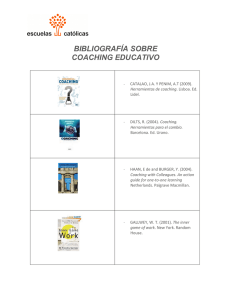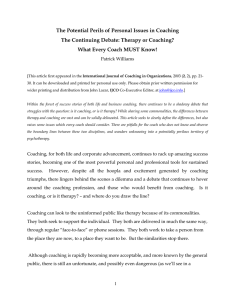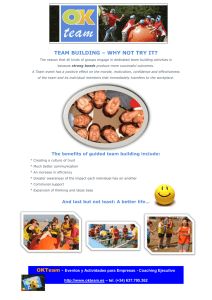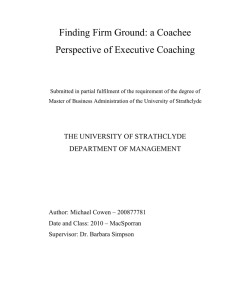- Association for Coaching
Anuncio
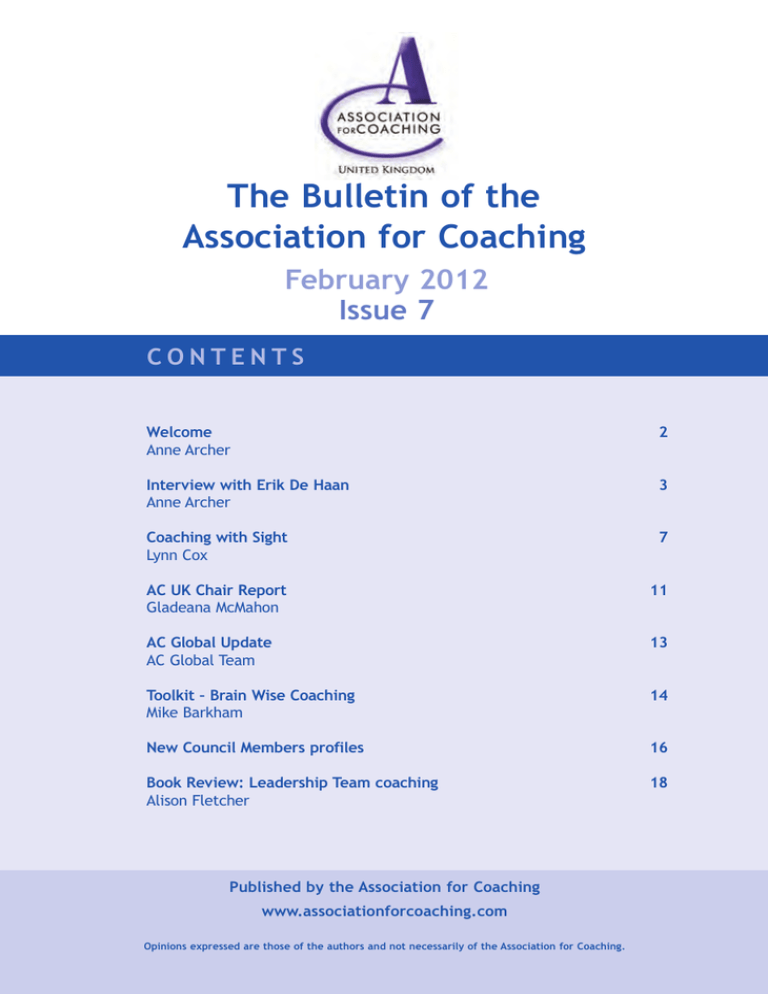
The Bulletin of the
Association for Coaching
February 2012
Issue 7
CONTENTS
Welcome
Anne Archer
2
Coaching with Sight
Lynn Cox
7
Interview with Erik De Haan
Anne Archer
3
AC UK Chair Report
Gladeana McMahon
11
Toolkit – Brain Wise Coaching
Mike Barkham
14
Book Review: Leadership Team coaching
Alison Fletcher
18
AC Global Update
AC Global Team
13
New Council Members profiles
16
Published by the Association for Coaching
www.associationforcoaching.com
Opinions expressed are those of the authors and not necessarily of the Association for Coaching.
Welcome
Welcome
Is it really 2012 and the year of the Olympics in
London? I for one think it is marvellous that we
can showcase our capital city and some of the
amazing sites of London. We are also celebrating
the AC’s 10th Birthday. This is a milestone in any
member organisation and it is testament to the
vision and hard work of our various councils that
it continues to grow.
In this bulletin we have our regular items. Erik de
Haan provides an interesting interview where he
shares his views on research, supervision and the
development of coaching. We have an inspiring
article by Lynn Cox who writes about coaching
without sight. It is quite thought-provoking. We
particularly enjoyed this edition’s Toolkit. Mike
Barkham has written about Brain Wise Coaching
– it’s well worth a read. Of course we have our
Global and UK Chair reports to keep us up to date
and photos and bios of the new council members.
To finish the bulletin Peter Hawkins’ Team
Coaching Book is ably reviewed by Alison
Fletcher.
We would like to take this opportunity to let you
know we have a new Book Review Editor,
Jonathan Wilson. Jonathan will, I am sure, be providing you with some interesting reviews over the
coming issues.
2
Anne Archer
Julia Cusack
In the spirit of doing something different or trying
something new, how about stepping forward to
help with producing the bulletin? Julia and I are
keen to expand the team and we have plenty of
opportunities for you to get involved if you would
like to. The bulletin is about to undergo a revamp
which is now coming together nicely so it is a
great time to come on board. We would love people with sharp editorial skills together with a real
passion about supporting the community with
useful and relevant information.
We hope you have a happy, healthy and prosperous 2012
Anne and Julia
editors@associationforcoaching.com
The Bulletin of the Association for Coaching • February 2012 • Issue 7 • www.associationforcoaching.com
Feature
Interview with Erik De Haan
By Anne Archer
What keeps you busy?
I work with Ashridge Consulting which is part of
Ashridge Business School. For the past 6 years I
have been heading up the Ashridge Centre for
Coaching; a centre of excellence for standards
and research.
I project manage and lead the 2 qualification programmes in coaching; the Ashridge Masters in
Executive Coaching and the Post Graduate
Certificate and Accreditation for Supervision of
Coaches and OD Consultants.
For the last 2 years I have been working with the
VU University in Amsterdam. This is more academic and they do not do consultancy from the
Faculty of Economics. I have taken the Chair of
OD and Coaching which is the first in Holland to
have coaching in the remit.
Organisation consultant, professor of OD, relational coach, supervisor and accreditor of consultants, researcher and leader of qualification programmes – that is how I would characterise my
‘busy-ness’.
How does the idea of pure
academic work in coaching sit
with you?
That’s a good question. I am interested in the
development of this field from practice to profession. Or in historical terms, from a free for all,
spontaneous, informal practice to a more rigorous, considered and reflected profession. I like to
inquire into the practice itself and to develop
standards as and when needed. I think some standards will really help us. A lot of people can create an hour of coaching that feels good. My ques-
tion is if this is doing or
delivering anything. Is
the person who is so fluent and good at relating
to others, aware of
where the strengths and
weaknesses lie of their
particular approach? I
believe accreditation and supervision are invaluable.
What have you created so far with
the research?
We have done some research into coaching outcomes where we ask the client and the coach
about the relationship, the motivation, the outcome – even their personalities. That was interesting but we have realised that more and more
we need large numbers to make solid statements
about what is going on in a statistical way.
I would therefore like to call upon all professional coaches to join us in that newest piece of quantitative research and contribute by participating,
see www.ashridge.org.uk/centreforcoaching.
Unlike in psychotherapy where there are huge,
rich clients who have an interest in research into
what works, e.g. the NHS who fund research, we
are not funded at the same level.
The coaching field is completely fragmented. We
do not have market forces operating behind the
research. We are therefore collaborating to tap
into large networks. We are offering to any organisation who contributes 50 data points, the opportunity to be listed as a co-author. One important
area we will be looking at is critical moments
within the coaching session.
Continued on page 4
The Bulletin of the Association for Coaching • February 2012 • Issue 7 • www.associationforcoaching.com
3
Feature
Continued from page 3
How are you defining coaching?
We had many exchanges about this from the point
of view of the research. I would say that mostly
this is a 1:1 relationship which is structured in
terms of a protected conversation in a safe space.
It is aimed at improving the fortunes of the client
in his/her work role.
How do you see supervision
evolving within the coaching
field?
There is still a lot we can learn about supervision
and coaching. In supervision you work with a
consultant or coach and you get echoing of other
relationships. It is a richer laboratory for clients.
There is an interesting shift away from the
clients’ stories and emotions. You get a perspective in the here-and-now relationship which
serves as a mirror of the client work. I find that
fascinating. I don’t think we have drawn the full
learning from parallel process in supervision. We
are at the early stages of understanding the relationship in coaching as well, in terms of incidents
or epiphanies or how they are related back to the
client context.
Do have a look at my new book on supervision if
you want to know more: Supervision in Action.
Who has surprised you recently?
Michel Moral. We were both contributing to a
book called Coaching & Mentoring Supervision.
We had the same topic – Organisation
Supervision – and we had not liaised or met about
it. Our chapters are interestingly different and still
both pointing at the same phenomena, around parallel process in organisations. Michel practises in
France. It is interesting how two writers from different countries are aligned.
4
How are you influenced by
supervision in other disciplines?
In my own training as a psychodynamic psychotherapist my supervision followed that model.
It is quite rigorous and you write up your sessions
in a lot of detail but in a freely associative manner. You end up with something that is like a
detailed ‘dream’ of your session, and that dream
is then analysed. It is fascinating and unusual in
the coaching world.
I have also read some of the American literature
about supervision, mainly relating to social work
supervision.
How might this influence the
development of coaching?
I think becoming more of a profession we might
become more creative. One way of being creative
is to look at how, in completely different parts of
the world, they are practising there. We do repeat
models that seem to work. However I hope we are
on the cusp of something new. I think particularly regarding parallel process as it is not fully
understood. There are other areas that are rapidly
moving in psychology, like attachment. Also neuroscience is often talked about today. I did my
PhD in neuroscience and I have some first-hand
knowledge of the field. The PhD has instilled in
me the huge complexity of the brain. This makes
me a bit cautious when I hear people talking
about neuroscience as a source for understanding
coaching or coaching relationships. They don’t
always realise how complex the central nervous
system is and how much is not known. It is interesting but too early to take it as a new dogma.
I agree that there is a huge development in our
understanding of how the brain works and I
expect it will yield some amazing findings and
results. I would say though at the moment we
need to be cautious. We are dealing with the most
Continued on page 5
The Bulletin of the Association for Coaching • February 2012 • Issue 7 • www.associationforcoaching.com
Feature
Continued from page 4
complex organ in the universe. We should get
inspired and then carefully analyse what we have
just learned.
What is the key for you of great
coaching?
I have seen hundreds of accreditations. Two main
features stand out.
1. Contracting. Particularly the contracting that
goes on within the session. You sensitise yourself to what the client is really looking for.
2. Being present with the other person.
Responding to what is happening. It is attending and being mindful of what transpires of
what we are co-creating right now.
If there is no shift in the room how can there be a
shift out there? I realise I am answering this at the
skills level. You could go to values as well: generosity and being on the side of the client, being
really invested in their thinking. Maybe there is
something about trust, generosity, self-awareness
and being able to enter the world of the client with
their norms, values and see it from how they see it.
If you could change one thing
what would it be?
I would get rid of flattery. There is a lot of seduction going on in our profession. A lot of money is
being made on the back of just looking good. In
the commercial sector where you can sell an hour
of time for hundreds of pounds, by flattering the
client, you have some believe you can solve their
problems for them. In our profession it’s more a
matter of opinion of whether it has worked.
I would change flattery for fearlessness. You have
to say what you feel, even if it is an awkward
truth. This is what you are paid for. Who else
would tell the client? It can be hard to say as
clients wield power, not just in their organisation,
but also over the coaching.
What about when you are not
doing this work?
I love the night life of being in London, the theatre and the opera. I have been inspired by films.
I used to be a projectionist in an art cinema and
saw Tarkovsky’s The Mirror 15 times. I wrote out
the dialogue and explored how it affected me.
Most recently I have seen the latest Woody Allen
film. I enjoy it when it moves me. I have also
written about Greek Tragedy and Shakespeare.
My wife and I do not go as much now because of
our young family.
I also enjoy following the hunt for the Higgs
boson, because my MSc thesis in Theoretical
Physics 1989 was about the Higgs field within the
standard model. After studying theoretical
physics I went on to take my PhD in
Psychophysics, a branch of neuroscience.
ADVERTISEMENT
HYPNOTHERAPY
Start A Rewarding New Career
Or Extend Your Coaching Practice
Hypnotherapy helps your clients with
Motivation Confidence
Stress Self esteem
Stop Smoking Weight Control
And more
It enhances your coaching practice, or
can be used as a standalone therapy.
YORKSHIRE
HYPNOTHERAPY TRAINING
Accredited, NOS compliant
Taster days available
Weekday/weekend learning
Enrol now for 2012
Debbie 01977 678593
www.yorkshirehypnotherapytraining.co.uk
The Bulletin of the Association for Coaching • February 2012 • Issue 7 • www.associationforcoaching.com
5
Advertisement
6
The Bulletin of the Association for Coaching • February 2012 • Issue 7 • www.associationforcoaching.com
Feature
Coaching without Sight
By Lynn Cox
Some coaches and clients find it surprising that a
successful international coach can operate when
they are registered blind. I just see it as what I do
and have never really delved into the situation.
Therefore, when I was asked to write this article,
I recognised that I had the opportunity to assess
how I uniquely operate as a coach and how that
might differ from others in the field.
As a background, I lost most of my useful sight in
my late teens. As a child I could see relatively
well to read, with a magnifying glass, but couldn’t recognise faces and could easily walk past my
best friend without saying hello. At 17 the
inevitable happened and I lost my reading vision
completely within a few weeks. Fortunately, I had
learnt Braille six months earlier and was competent on a computer with speech output, having
also learnt to touch type in my early teens. My
colour vision faded five or so years later at about
the age of 22 and now, some 23 years on, I only
have a little light and dark perception. I also know
that all vision will be gone very soon.
I do think blindness is a matter of the mind as
much as the eyes. Being visually impaired has
been a privilege for me. I’ve learnt to recognise
the size of a room by the echo; learnt not to worry
if I’ve just missed the bus which I couldn’t see
waiting at the stop; I can still mentally picture any
scene and not worry if I have some details wrong,
and I can definitely smell out any cuisine of food
from 3 metres away.
My background is as a visual artist, multi-sensory workshop leader, mentor, equalities trainer and
access consultant for museums and galleries. At
the time coaching seemed to be the natural progression for my career, as I was enjoying my
work as a mentor for disabled and non-disabled
artists more than making my own artworks,
although I recognized that I needed training to be
more effective at my job.
I formally trained as a
coach nearly three years
ago on the Cultural
Leadership Programme’s
Dynamics of Leadership
Course, with Carol
Wilson and Deb Barnard
as my tutors, so I had an
excellent introduction into the profession. The exercise on the course that I recognised worked very
well for me as the client, and I felt comfortable with
using in coaching, involved moving in the room
and walking the path of your goal (Spatial Goal
Setting). I suspect that Carol and Deb found this the
hardest technique to teach me, as they had logistical problems that they didn’t want me to walk into
others practising the technique, and the worry of
moving someone, who can’t see where they are
going around a room, safely.
Subsequently, I trained as a Clean Coach with
Angela Dunbar, where the toolkit involves Clean
Language and Emergent Knowledge techniques.
Clean Language involves visually modelling, on
paper or in your head, a client’s metaphorical
landscapes by using a limited set of questions.
Emergent Knowledge utilises iteration in spatial
environments and pictorial representations to
assist the client to discover deeper understanding
of their situation.
Currently, I’m coaching a variety of different people from CEOs of arts organisations, to students
and unemployed disabled jobseekers, to
employed individuals under stress, both in the
UK and abroad (via face- to-face sessions, telephone and Skype).
So, what I really need to ask myself now, is why
someone who can’t see wants to work primarily
with their clients by using images and space? And
you might be asking yourself the same question!
Continued on page 8
The Bulletin of the Association for Coaching • February 2012 • Issue 7 • www.associationforcoaching.com
7
Feature
Continued from page 7
Using the Fleming VARK Model of learning
styles (visual, auditory and kinesthetic/tactile
learners) {1}, I recognize that my natural learning
styles would be visual, kinesthetic/tactile and
auditory. However, due to my visual impairment
I’ve had to adapt to the learning styles of auditory,
tactile/kinesthetic and visual. In reality this means
I take in information primarily on an auditory
level but then mentally transfer it into visual
images for myself. This means I can easily operate
in different learning styles, because I’m so used to
manipulating them to meet my own needs. The
tactile/kinesthetic style is interesting and I would
put them that way around because tactile replaces
part of my visual input. The kinesthetic is my least
favoured style, but I always learn something more
significant by using a learning style that doesn’t
feel so natural to me.
When coaching I like to use the same transfers of
learning styles. I do acknowledge that we learn
very effectively in our own preferred learning
style, but I also recognize that clients can learn
more by being gently encouraged to go outside
their learning comfort zones. For example, I invite
people to verbalise their drawings of their goals,
which then enables me to ask the relevant questions to move their understanding on. After all, the
clients will notice the important elements of their
drawing, so it doesn’t matter if I can’t see the picture - in fact, I have an advantage in not seeing the
drawing as I’m not tempted to put my own interpretations on the picture and ask leading questions.
I also challenge the dual misconceptions that 6070% of our interpretation comes from non-verbal
cues and that a visually impaired person can’t
master most of these non-verbal cues.
James Borg states that human communication
consists of 93% body language and paralinguistic
cues (such as stance, tone of voice, etc), while
only 7% of communication consists of words
themselves {2}. However, Albert Mehrabian, the
researcher whose 1960s’ work is the source of
these statistics, has stated that this is a misunderstanding of the findings {3}. Mehrabian’s
8
research only dealt with feelings and attitudes
being conveyed, where he found that when the
situation wasn’t congruent subjects relied 7% on
the words, 38% on tone of voice and 55% on nonverbal cues. Others assert that “Research has suggested that between 60 and 70% of all meaning is
derived from non-verbal behavior.” {4}
Since the Mehrabian research of 1967, other studies have analysed the relative contribution of verbal and non-verbal signals under more naturalistic situations. One in 1970, using video tapes
shown to the subjects, analysed the communication of submissive/dominant attitude and found
that all types of non-verbal cues combined - especially body posture - had 4.3 times the effect of
verbal cues {5}. On the other hand, another in
1992, dealing with the communication of
happy/sad mood, found that hearing words spoken in a “flat” voice was about 4 times more
influential than facial expressions seen in a film
with no sound {6}, therefore explaining how we
can all do telephone coaching effectively without
seeing our clients. Thus, different studies may
reach very different conclusions dependent on
methodology and we have to take into account the
type of coaching we are undertaking.
My supposition is, that because I’m primarily
using word and tone of voice for all of my interactions in the world, not just when I’m coaching, that
I’ve put a greater emphasis on honing these skills,
in order to maximise my understanding of people’s
meanings. This potentially makes me a more effective telephone coach than someone who places
more emphasis on non-verbal clues. This argument
doesn’t even take into account the non-verbal
interpretations that I’m used to assessing on a dayto-day basis. The sounds that are received from
down the telephone line, such as fidgeting, moving
around, tapping, drinking, clicking pens and
swinging their chair around, also give essential
information to the telephone coach.
Again, with face-to-face spatial techniques, I can
hear the client’s movements, such as the pace of
their walking, direction, angle to the upright and
Continued on page 9
The Bulletin of the Association for Coaching • February 2012 • Issue 7 • www.associationforcoaching.com
Feature
Continued from page 8
body positioning (for instance, once they talk to
me I might be able to tell that they are looking
down). All valuable non-verbal information.
There are also some advantages to not seeing a
client in a face-to-face or Skype session. I don’t
take people’s visual look into account (so I don’t
get the chance to make subconscious stereotypical assumptions), I don’t get confused by clients
using different cultural body language (which can
be mis-read), and most importantly I often don’t
get fooled by people who have managed to learn
body language techniques to cope with the world.
I’ve now decided to use the unique insight of not
seeing to influence my own coaching practice.
Ever since 1994 I’ve been playing about with the
positive effects of darkness; trying to dispel the
myth of darkness being a negative and evil force
that is to be avoided. I’m very interested in delving into the notions that a lack of a sense can gen-
Lynn Cox Bio
Lynn is owner/director of Arts Coaching
Training (ACT), which specialises in delivering
interactive and multisensory professional development programmes for individuals and organisations. She is also instigating ‘The Power of
Darkness’- a coaching, training and arts experience delivered in total darkness.
She is currently researching how darkness positively and negatively affects people throughout
the world from prehistoric times onwards.
Lynn also speaks on the subjects of the privilege
of visual impairment and creating an inclusive
society.
If anyone would like to find out more about
Lynn’s practice then please contact her on
07818 437 651 or lynn.cox1@virgin.net.
erate emotional and physical reactions, which
enable others to discover their senses and perceptions anew, or it opens their psyche to new possibilities. This recurring theme of ‘The Power of
Darkness’ is becoming more and more the basis
for my future coaching, training and artistic
explorations, as I’m creating total immersion in
dark spaces.
In conclusion, I don’t think what I do is that different from any other coach. I might use multisensory questioning a bit more, prefer spatial and
pictorial techniques and switch clients’ learning
styles to meet my needs and challenge theirs. In
the near future coaching in the dark will be on
offer too.
References
1. L d Pride. (n.d.). What are learning styles?
2. Borg, James. Body Language: 7 Easy Lessons
to Master the Silent Language. FT Press,
2010, ISBN 9780137002603.
3. More or Less. BBC Radio 4. 13:30-14:00.
4. Engleberg, Isa N. Working in Groups:
Communication Principles and Strategies.
My Communication Kit Series, 2006. page
133.
5. Argyle, Michael; Salter, Veronica; Nicholson,
Hilary; Williams, Marylin; Burgess, Philip
(1970). "The Communication of Inferior and
Superior Attitudes by Verbal and Non-verbal
Signals". British Journal of Social and
Clinical Psychology (9): 222-231.
6. Hsee, Christopher K.; Hatfield, Elaine;
Chemtob, Claude (1992). "Assessments of the
Emotional States of Others: Conscious
Judgments versus Emotional Contagion".
Journal of Social and Clinical Psychology 14
(2): 119-128.
The Bulletin of the Association for Coaching • February 2012 • Issue 7 • www.associationforcoaching.com
9
Advertisement
Diploma in Leadership Development &
Executive Coaching 2012
A stimulating and thought-provoking programme which encourages you
to develop your skills and professional stance when facilitating enhanced
performance for your client or team. The course is designed for
professionals who wish to develop and deepen their skills as change
agents within organisations or as coaching practitioners. This training
supports you in providing one-to-one coaching to executives or working
with management teams to improve effectiveness. A team of renowned
tutors including Tony Goddard, Professor Renos Papadopoulos, Professor
Ernesto Spinelli, Liz Macann, John Whittington, Sharon Eden, Alison Hodge.
Full details on the Courses page of our website.
Contact Sarah Briggs: sarah@counselling.org
Executive Desert Journeys 2012
Tailor-made for individuals or teams: explore
your leadership style with high-impact
professional development on a camel ride
camping in the Egyptian desert.
See our website or email Ben McKie,
journey leader: info@counselling.org
020 7637 7763
10
www.counselling.org
The Bulletin of the Association for Coaching • February 2012 • Issue 7 • www.associationforcoaching.com
AC UK Chair Report
Chair’s Report Jan 2012
By Gladeana McMahon
I hope everyone had an excellent Festive season.
Another year is now upon us with all the hopes and
aspirations that each New Year brings.
We held our elections for the AC Council positions
that were due for re-election in 2011 last
November. It has been sad to see Annabel Harper,
Head of Communications, and Amanda Bouch,
Vice Chair, stand down. Both have worked tirelessly during their term of office and have generously agreed to stay on to complete a number of
initiatives which they have been closely involved
in.
to ensure that volunteer
contributions are recognized once the new website is up and running.
Katherine Tulpa, Alex
Szabo
and
Darren
Robson (with input from
a number of additional
volunteers) have put hundreds of hours into this
project. The website has proved far more challenging than anyone had expected.
However, it is my pleasure to introduce the new
Council members that you, our membership, have
officially elected.
If you have time to devote to the AC, whether on
an ad hoc basis or via a more regular commitment,
you will always be welcomed. Everyone, apart
from our Virtual Assistants and professional external advisers such as our accountants, is a volunteer.
Declan Woods and I, who were elected last year,
continue in our current roles: Declan as Head of
Professional Standards and Accreditation, and
myself as Chair. We are still without a Vice Chair
but I hope to be able to provide some good news
regarding this position in my next Chair’s Report.
As always, keep on letting us know what you
appreciate and like about the AC and what you
would like us to do more of. We also want to know
what we could be doing better or differently. It is
our constant aim to ensure we meet the needs of
our members and to do that we need you, our members, to help us.
Head of Communications:
Head of Marketing:
Head of Corporate Services:
Head of Professional Forums:
Heads of Operations:
Matt Somers
Gill Smith
Alexandra Sleator
Helen Tiffany
Ann Moran and
Janet Beardmore
(Job share)
I would like to thank each and every one of our
volunteers (over 200) for their time, energy and
enthusiasm. We would not have achieved 10 years
as an Association without the help that all volunteers past and present have given. It is our intention
In 2012, which is the 10th Anniversary year of the
AC, our conference theme is From Inner Game to
Neuroscience. Sessions will look at key development in coaching and what we can expect in the
future. The conference will be in Edinburgh on
Friday 22nd June, so book it into your diaries now!
Gladeana McMahon
“The art of being wise is knowing what to overlook”
— William James
The Bulletin of the Association for Coaching • February 2012 • Issue 7 • www.associationforcoaching.com
11
Advertisement
Centre for
Coaching
in association with Centre for Stress Management
promoting the cognitive
behavioural approach
Diplomas†
Advanced Certificates*
Primary Certificate Courses
Modular programmes in:
Coaching
Psychological Coaching
Coaching Psychology
Certificate Courses*
Accredited by Middlesex University
Coaching
Stress Management and
Performance Coaching
Stress Management and Health Coaching‡
Coaching Psychology (for psychologists)
Psychological Coaching
Performance Coaching
Health Coaching
Stress Management
Occupational Stress Management
Assertion & Communication Skills
Problem Focused Counselling Coaching & Training
Coaching Supervision
Redundancy Coaching
Mediation Skills
Correspondence Course
Life Coaching - a CBC approach
Courses held in London unless otherwise
stated and can be run in-house
The Centre for Coaching is an ILM Recognised Provider. As a
recognised provider, the Centre runs a wide range of coaching
and management development programmes which are suitable
for Continuing Professional Development.
The Director of the Centre is
Professor Stephen Palmer PhD CPsychol.
Trainers include:
Professor Stephen Palmer
Nick Edgerton
Gladeana McMahon
Michael Neenan
Recognised Course
Dr Siobhain O’Riordan
Kasia Szymanska
Irene Tubbs
Visit our website for course dates and fees:
www.centreforcoaching.com
Contact us for our non-certificated workshop CPD programme.
* Courses recognised by
the Association for Coaching
‡ This course not accredited by Middlesex University
Part of the International Academy for Professional Development Ltd Group of Centres (IAPD)
12
The Bulletin of the Association for Coaching • February 2012 • Issue 7 • www.associationforcoaching.com
AC Global Update
AC Global Team Update
Firstly, we hope you had a very happy Christmas
and New Year with your families and we hope
that you have come back refreshed and ready for
action in 2012.
2012 our Olympic year
As many of you will be aware this year is the
Association for Coaching’s 10th anniversary and
with the Olympics in London during the summer
we are really looking forward to raising the bar
and providing our members across the world with
an enhanced AC experience.
We will be communicating soon to all of our
members about the delivery date of the new web
platform which we hope you will find more intuitive and easier to navigate. It will have new fresh
content with the development of AC TV and will
allow you as members to manage your personal
web profile and communication requirements.
AC Leadership teams
The Global team spent the day with the AC team
in Ireland in December and we were proud to hear
all of the developments this team has managed
over the course of the last year. They have developed great relationships with the corporate and
3rd sector and have really moved the social innovation agenda forward in Ireland.
The AC UK team have recently added more talent
to their number and we look forward to working
in collaboration to provide you with enhanced
services, events, knowledge and information. We
are looking forward to promoting the AC UK
Conference in Scotland in 2012, this is a really
exciting initiative as it’s the first major conference outside London in the UK.
Strategic Partnerships
I’m pleased to share that the conversations with
the global leadership teams of both the ICF and
the EMCC are now moving forward in a positive
way. We will be part of a joint call this month
where we come to consensus on the areas where
it makes sense for our mutual bodies to collaborate and share information. As these conversations progress we will come back to share this
information with you.
I’m also pleased to say that the AC will be a premium sponsor of the forthcoming Roche Martin
Emotional Intelligence conference in London.
This is a global relationship with an organisation
that is rapidly expanding into emerging markets
that align with our strategic plan.
We hope soon to be able to share with you a further announcement about some very exciting
country expansions and training provider partnerships that we are building to provide our members
with exclusive offerings.
Going Global
In January the global board will be announcing
some exciting new international posts that we are
now ready to have filled. These roles will be
aligned with our strategic plan and will enable us
to grow the AC across the world in key strategic
hubs where it is important that we have a presence and relationships.
Best wishes
AC Global team
The Bulletin of the Association for Coaching • February 2012 • Issue 7 • www.associationforcoaching.com
13
Toolkit
Taking a brain-wise approach to
emotions
By Mike Barkham
Knowing
something
about the neurobiology of
emotions can really help
when coaching in what I
call the “high IQ” businesses such as financial
services, consulting, law,
and IT. Here people develop technical expertise and
achieve success primarily using their IQ, and the
challenge for them as leaders is to unblock and use
their EQ. There are two reasons why, for these
clients, I take a brain-wise approach:
• Coaching effectiveness: It explains how emotions
affect both thoughts and actions, and why even here
it’s important to focus on them.
• Client engagement: The fact that what I do is supported by science helps my very rational clients
accept my focus on emotions and engage in nonrational (creative) coaching exercises. It is their
engagement in this type of work that helps to make
the coaching more effective.
Neurobiology is such a big subject that it’s helpful to
put some boundaries around it. You don’t need to
know that much! The essentials you need in order to
put the science into practice are:
• Areas of the brain: As a working model, you need
only distinguish the brain stem, the limbic, which is
where we process emotions, the neo-cortex, and
within that the pre-frontal cortex (PFC), which is
where we do “new” thinking and decide on intentional rather than habitual action. It is also important to recognise the different internal worlds of the
left and right hemispheres, one linear and rational,
the other unconstrained, experiential, and much
better connected to the limbic.
14
• The “see-saw” relationship between emotional response and
intentional action: In
simple
terms,
the
stronger our limbic’s
emotional response to a situation, the less we are
able to use our PFC to think and act intentionally –
so we are thrown back on habitual patterns, often
without even realising it. The most powerful “derailing” emotions arise from perceived threats,
which may be genuine but are more often falsely
created by unconscious associations from the past.
• Good and bad ways to manage an emotional
response: Contrary to what our culture tells us, it
isn’t a good idea to try to suppress emotions! The
best ways for someone to reduce their limbic’s
response are:
o Labelling: This means naming, in your head
or perhaps even out loud, the emotional
response or the threat, for example “I’m
angry” or “That’s just my usual fear of looking foolish”. It seems that recognising emotion distances you from it and seeing it as
familiar makes it less threatening.
o Re-framing: This means changing the way
we perceive a situation to turn it into an
opportunity rather than a threat. For example,
a job interview might be a chance to find out
whether the job suits you, rather than whether
you are good enough to do it.
o Breathing: Strong emotions tend to make us
catch and hold our breath. It is breathing out
that starts to calm our limbic response.
Simply making breaths slow, long and regular
works well, or you can use more advanced
practices (from yoga or similar).
Continued on page 15
The Bulletin of the Association for Coaching • February 2012 • Issue 7 • www.associationforcoaching.com
Toolkit
Continued from page 14
• Limbic resonance: You need to know that emotions can be passed from one person’s limbic to
another’s through emotional resonance circuits,
part of which are our so-called “mirror” neurons.
Emotions pass between a leader and their team, and
between the coach and coachee during coaching.
This is another reason why coaches (and leaders)
need to focus on emotions.
So how would you actually see this knowledge being
applied in my coaching sessions? I have noticed the
following small changes:
• More frequent choice of “right brain” methods:
What the neurobiology confirms is that “right
brain” methods are best for bringing unconscious
emotional responses into consciousness. These are
the creative and experiential methods, such as looking at or drawing pictures, using symbolic imagery,
drawing on archetypal characters in films, stories
and myths, exploring a positive visualisation, physically changing positions in the room – the list is
almost endless. I used to try these methods only
occasionally; the science has given me the confidence to make them core tools.
• Better explanation of my choices: If I am going to
suggest a particularly non-rational right brain technique (such as “two-chair” work where the client
sits in another chair and literally looks back at
themselves) it helps to be able to use the science to
explain why it’s not just magic!
• Helping clients visualise change in terms of the
brain: Sometimes the easiest way to help someone
label their emotional response and re-frame the situation is by using the simple model of the brain.
For example they can think: “That’s just my limbic
reacting to its own assumptions, and this is an
opportunity to see what I think if I make the opposite assumption”.
• Using myself better: Knowing that my own emotions during coaching might be resonance with my
coachee, I am now more likely to share what I
experience, both to help them become more aware
and to increase our emotional connection.
There are also two over-riding practices that were
always core to my approach but which the neurobiology confirms are fundamental. They are:
• Focusing on connection rather than content: It is
the relationship of trust that produces oxytocin (the
same brain chemical produced by the childhood
attachment of a baby to its mother) which encourages new neural connections in the brain. That’s
genuine change!
• Working on yourself, the coach: It is critical that
you have learned to notice emotions, to differentiate your own from your client’s, and to be comfortable about engaging with and managing both.
If this has whetted your appetite and you want to
learn more about the brain, the two best sources are
David Rock and Dr Daniel Siegel. Rock primarily
focuses on the role of the leader as the “head” of the
team. Siegel provides a model which addresses the
leader as both “head” and “heart” – a much more
holistic approach, and one which deals with emotion
as a positive not just a negative. You will find relevant links on my website (below).
Mike Barkham Bio
Mike is an executive coach with a broad and
deep business background from his years as a
partner at PricewaterhouseCoopers.
His approach to coaching links traditional psychology with the latest neurobiology in support
of his core “Corleone” philosophy that “business is always personal”.
For more about Mike and/or Corleone, visit
www.explainingcorleone.co.uk
The Bulletin of the Association for Coaching • February 2012 • Issue 7 • www.associationforcoaching.com
15
New AC UK Council Members
New AC UK Council Members
Janet Beardmore
Joint Head of Operations
Janet is a member of
the AC, holding a postgraduate certificate in
Personal & Business
Coaching from the
University of Chester.
She also holds an
accredited Mediation
Practitioner Certificate
and is thus qualified to
facilitate
workplace
mediation. An extensive
HR career, working at both the operational and
strategic levels, has qualified Janet as a Fellow of
the Chartered Institute of Personnel and
Development; this experience is supported by a
postgraduate diploma in Personnel Management,
gained at DeMontfort University. Janet initially
developed her coaching and mediation experience
whilst working as a senior HR manager, before
deciding to run her own consultancy business,
Lee Ho Development Ltd.
Ann Moran
Joint Head of Operations
Ann is a member of the
Association for Coaching
and holds an Advanced
Certificate in Executive
Coaching. Ann developed
her
coaching
expertise and formal
qualifications
whilst
working with large public sector organisations,
providing coaching and
16
human resources consultancy support to senior
leadership and management colleagues. Ann has
extensive experience of strategic and operational
human resources, is a Fellow of the Chartered
Institute of Personnel and Development and holds a
postgraduate
qualification
in
Personnel
Management from Nottingham Trent University.
Ann is also a qualified and experienced workplace
Mediator, holding a Certificate in Workplace
Mediation. Ann now provides HR consultancy,
coaching and mediation advice and expertise as a
Director of Blue Chair Limited.
Helen Tiffany
Head of Professional Forums
Helen has been a professional coach for over 10
years and has extensive
experience working with
senior management teams
and board directors.
She helps companies create coaching cultures and
set up coaching academies to allow corporates
to develop their own
internal schemes.
Helen believes that coaching helps to facilitate
change and accelerate learning to improve performance. Her approach is to use tools and techniques
that are bespoke to the individual and to create thinking space, a real commodity in these challenging
times.
Helen is also a member of the EMCC, the BPS and
Fellow of the Chartered Institute of Personnel and
Development.
Continued on page 17
The Bulletin of the Association for Coaching • February 2012 • Issue 7 • www.associationforcoaching.com
New AC UK Council Members
Continued from page 16
Matt Somers
Head of Communications
Matt Somers is a coaching practitioner of many
years’ experience and
works with a host of
clients in North East
England - where he is
based - and throughout
the UK and Europe.
Matt understands that
people are working with
their true potential locked
away. He shows that coaching provides a simple yet
elegant key to this lock and that releasing potential in
this way transforms the performance of all organisations.
Matt is a regular speaker and the author of many articles on coaching. His book Coaching at Work was
published by Wiley & Sons in 2006 and its followup Instant Manager: Coaching published by Hodder
& Stoughton in 2008. Matt holds an MSc in Human
Resource Development and is a Fellow of the
Chartered Institute of Personnel & Development.
Alexandra Sleator
Head of Corporate Services
After 23 years in the
financial services industry
where she held a large
variety of senior roles,
Alexandra now works
full-time with high-performing professionals,
principally in the financial sector, to support
them in realising their
career aspirations.
Alexandra leverages her corporate background to
both increase the corporate membership of the AC
and develop the AC’s content specifically for that
segment of the membership base.
Alexandra holds a number of qualifications in
Cognitive Behavioural Coaching from the Centre for
Coaching.
Jonathan Wilson
Book Review Editor
After twenty years in
the independent airline industry and
twenty years as a
strategic consultant
and executive coach,
I remain fascinated
by how people work
with each other and
doing what I can to
help them be better
together, however
they choose to define
better.
The Bulletin of the Association for Coaching • February 2012 • Issue 7 • www.associationforcoaching.com
17
Book Review
Leadership Team Coaching:
Developing collective
transformational leadership
Peter Hawkins Kogan Page (London) 2011
ISBN 978-0-7494-5-883-6
RRP £24.99
By Alison Fletcher
An on-the-money model, a liberal dose of anecdotes
and some practical techniques that will have coaches
reaching for their tools and tips notebooks – you
know where you are with a Peter Hawkins book and
this one won’t disappoint.
It’s unlikely to surprise either, as Peter is nothing if
not self-referential and if you already have his last
book ‘Coaching, Mentoring and Organisational
Consultancy’ you will find much that is familiar if
not actually duplicated.
But as clarifying light in the murky world of team
coaching/facilitation/team building/weird stuff, it
hits the spot and does a good job of arguing the case
for team coaching as a distinct discipline.
It builds on Peter’s argument that executive coaches
have for too long over-served the individual and
under-served the organisation and introduces the
helpful concept of outside-in team coaching. The
heart of the book – for those short of time seek out
page 36 – is his model of the Five Disciplines of
high-performing teams.
If you’ve struggled to understand and remember the
Seven-Eyed Monster and find yourself getting your
modes mixed up, I’m happy to report that this is altogether catchier and has a simple elegance that the
afore-mentioned curate’s egg lacks. Perhaps that’s
because it is only one step removed from the classic
two by two matrix and has the both-and emphasis
that I personally find one of the most insightful elements of the Hawkins model of supervision.
18
Also helpful and incisive is the definition of
systemic coaching as designed for teams working
both together and apart, doing business as usual
and transforming the business. Again, the need
for coaches to prepare teams to work with
unprecedented complexity and speed of change,
gives the model a breadth and scope that leaves
far behind the conventional idea of team coaching
as focussed on helping teams be nicer to each
other.
Somewhat less simple and elegant is the exposition on developing a team coach’s capabilities,
capacities and competencies where I struggled to
see the difference between each category. And
the list of requirements is so long that I’m
reminded of Elizabeth Bennet in Pride and
Prejudice who exclaimed she was surprised that
Darcy knew even one accomplished woman on
hearing the compendium of attributes he required
for accomplishment to be demonstrated.
Elsewhere in the book Peter states that most team
coaching is done by team leaders, but the tone of
the book, and this section in particular, seems
aimed squarely at the full-time professional coach
rather than the leader taking a coaching approach.
That aside, this is an excellent book and for those
already working in this area or contemplating their
first assignment, it should be required reading.
The Bulletin of the Association for Coaching • February 2012 • Issue 7 • www.associationforcoaching.com
